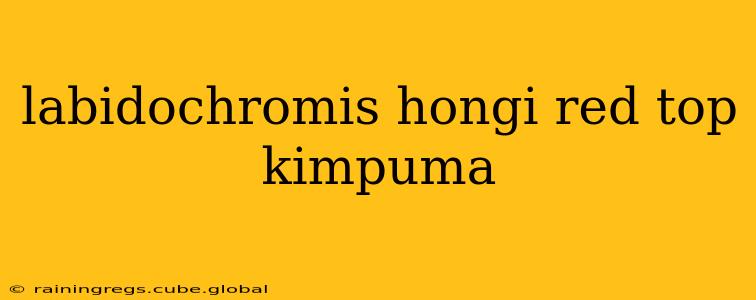The Labidochromis hongi "Red Top Kimpuma" is a stunningly beautiful and popular cichlid species among aquarium hobbyists. Its vibrant coloration and relatively peaceful temperament make it a desirable addition to community tanks, but understanding its specific needs is crucial for success. This comprehensive guide will delve into everything you need to know about caring for this captivating fish.
What is a Labidochromis Hongi Red Top Kimpuma?
The Labidochromis hongi "Red Top Kimpuma" is a stunning mbuna cichlid hailing from Lake Malawi in Africa. The "Kimpuma" designation refers to a specific color morph characterized by its intense red coloration on the top half of its body, contrasting sharply with its lighter, often yellowish or bluish lower body. This striking coloration, coupled with its relatively smaller size compared to other mbuna, makes it a favorite amongst aquarium keepers. Unlike many other mbuna, L. hongi are generally considered less aggressive, but proper tank setup and stocking are vital for their well-being.
What are the care requirements for a Labidochromis Hongi Red Top Kimpuma?
Providing optimal care for Labidochromis hongi "Red Top Kimpuma" involves a careful consideration of several factors:
Tank Size and Setup:
A minimum tank size of 30 gallons is recommended for a small group of these fish. Larger tanks are always better, offering more swimming space and reducing aggression. The tank should be well-decorated with plenty of rocks, caves, and hiding places to mimic their natural habitat. This provides territories for individual fish and reduces stress. Avoid sharp decorations that could injure them. A strong filtration system is a must, as mbuna produce significant waste.
Water Parameters:
Maintaining stable water parameters is paramount. Labidochromis hongi thrive in slightly alkaline water with a pH range of 7.8-8.5 and a temperature between 75-82°F (24-28°C). Regular water changes (25% weekly) are essential to maintain water quality and prevent the buildup of harmful nitrates. Use a reliable test kit to monitor water parameters regularly.
Diet and Feeding:
These cichlids are omnivores with a preference for a varied diet. High-quality cichlid flakes or pellets should form the basis of their diet, supplemented with spirulina-based foods, live or frozen foods like daphnia, brine shrimp, and mysis shrimp. Avoid overfeeding, as this can lead to water quality issues. Feed multiple small meals per day rather than one large meal.
Tank Mates:
While generally peaceful compared to other mbuna, L. hongi are still territorial, especially during breeding. Careful selection of tank mates is crucial. Avoid highly aggressive species. Consider compatible species of similar size and temperament. Overstocking should be avoided at all costs.
Breeding:
Breeding Labidochromis hongi in an aquarium is possible with proper conditions. The female will lay eggs in a chosen cave or crevice, and the male will fertilize them externally. The female will then incubate the eggs in her mouth for about 3 weeks. Fry are relatively easy to raise with a diet of finely crushed food.
How aggressive are Labidochromis Hongi?
L. hongi are considered relatively peaceful compared to many other mbuna species. However, they can still exhibit territorial behavior, particularly towards other L. hongi and similar-looking species. Providing ample hiding spaces and avoiding overstocking significantly mitigates aggression. While they might not be suitable for a community tank with exceptionally timid fish, they generally coexist well with appropriately chosen tank mates.
What size tank do Labidochromis Hongi need?
As previously mentioned, a minimum of 30 gallons is recommended for a small group (6-8) of Labidochromis hongi. However, a larger tank, 55 gallons or more, is highly preferable to provide sufficient swimming space and reduce stress, minimizing the likelihood of aggression.
Are Labidochromis Hongi good for beginners?
While Labidochromis hongi are less demanding than some mbuna species, they still require a certain level of commitment to proper water parameters and husbandry. Beginners with some experience maintaining a planted aquarium or a simple community tank will likely find them manageable. However, thorough research and preparation are still essential for success.
This guide offers a detailed overview of caring for Labidochromis hongi "Red Top Kimpuma." Remember that providing a stable environment, appropriate tank mates, and a healthy diet are crucial for the well-being and vibrant coloration of these beautiful cichlids. Remember to always consult additional resources and experienced aquarists for further guidance before embarking on your cichlid keeping journey.
